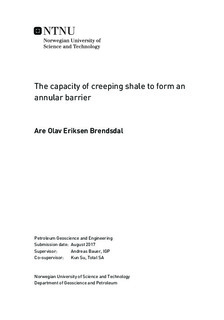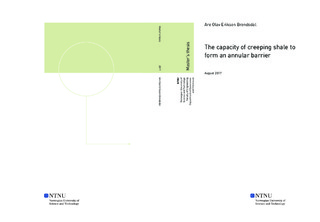| dc.description.abstract | This report was written in Pau, France, as part of an internship in Total E&P Drilling & Wells Division, Geomechanics Entity, under supervision of Kun Su. Shale displacing inwards in the wellbore is a well-recognized phenomenon, but not so well understood. For certain shales under certain conditions the degree of deformation can be enough to impinge the casing, and eventually completely close the annular gap between the formation and casing wall. For such cases shale can potentially replace cement as external barrier if it is correctly verified through logs and pressure testing. This can form a cost-efficient and convenient solution in for example P&A operations. Calculations show that shale has to undergo plastic deformation in order to displace sufficiently, and in most cases time dependent plastic (viscoplastic) deformation is required (often called creep). Plasticity and creep in shales and other clay rich rocks is a fluid driven interparticle process depending on several rock parameters and borehole conditions. This thesis investigates some of the geomechanical aspects of the displacement process, and through a literature review and field cases, discusses how the creeping capacity of shales is linked to different characteristic and conditions. Experiments show that creep is more profound in weak unconsolidated formations, porosity is usually an excellent indicator for degree of compaction. Typically, high amounts of clay minerals (in particular smectite) and small amounts of typical cementing materials like quartz and carbonate appears to enhance creep. It is found that creep generally increases at higher temperature and higher deviatoric stress, and that rocks like shale display a significant amount of anisotropic creep behavior related to bedding planes and load direction. Typical creeping formations can have low in-situ deviatoric stresses as they have deformed and stabilized for millions of years, these low deviatoric stresses could potentially indicate a formations threshold for creep. Some petrophysical log measurements can to some degree be linked to the creeping capacity of a formation. High porosity, low sonic velocities and density readings are potential indications to look for, if combined with high pore pressure it could potentially lead to a creeping formation. Two different shale formations in the North Sea in wells drilled by Total E&P has been analyzed. The shale in the Hordaland group shows high creeping capacity and potential use as barrier, this matches well with trends observed from literature and available industry experience. For a deeper shale, numerical simulations, a creep test, mineralogy and analytical solutions and more show that despite some traditionally good conditions for creep (high temperature and pore pressure) this shale is not likely to creep sufficiently to form a barrier. | en |

